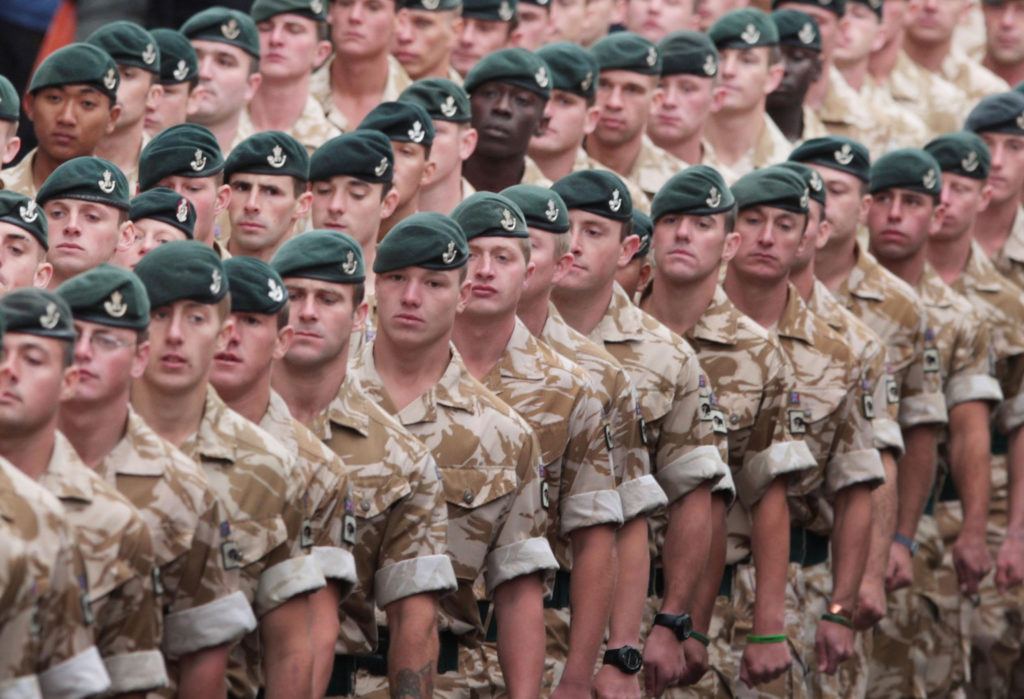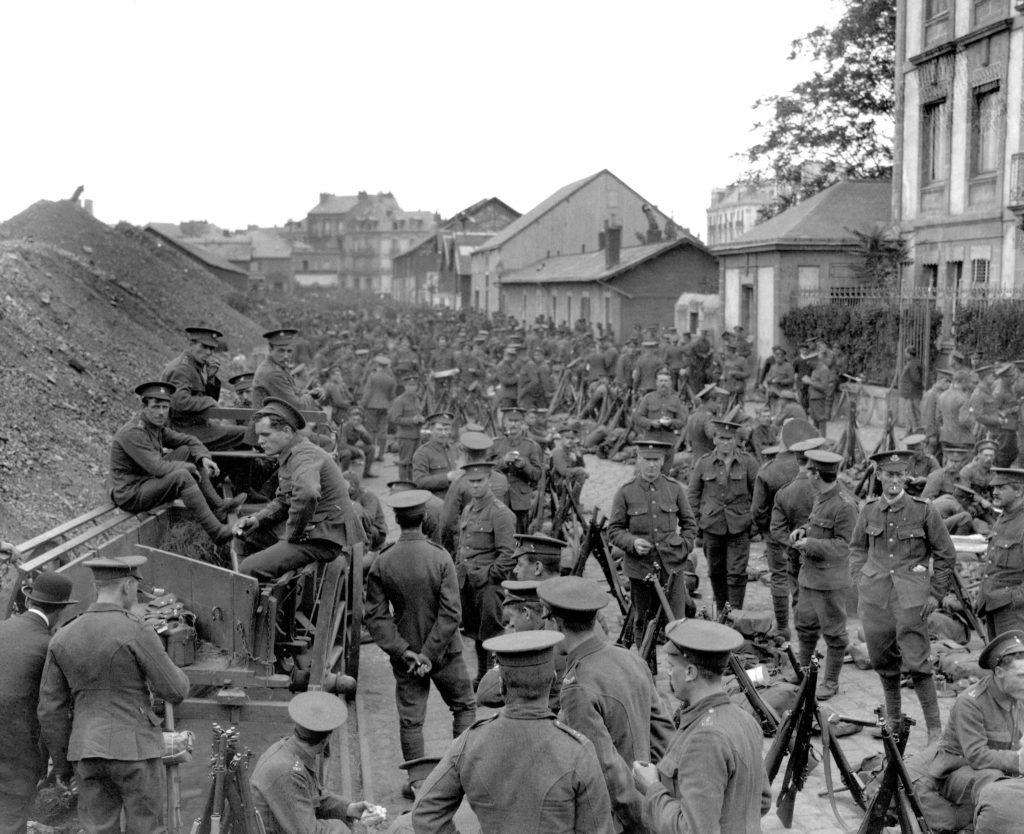British soldier in Helmand, Afghanistan. Credit: Ben Birchall/PA Archive/PA Images

The Greeks had a word for ‘army’ – stratos, meaning simply ‘a body of men’. The Romans had an even better one – exercitus, meaning, in the abstract, ‘work’ or ‘training’. The Romans thereby defined their army not so much by what it looked like – its form – but by what it did.
I was minded of this on Saturday at the Royal Military Academy Sandhurst, where the Chief of the General Staff, Sir Nick Carter, was addressing the Territorial Army’s annual ‘symposium’. Or rather, the Reserves, as the old TA is now called, better to reflect its purpose – that it is no longer specifically for home defence, but a pool on which the regular Army can draw. In fact, the TA hasn’t been confined to territorial defence since the First World War, but the brand name was good, like the United States National Guard. Now the name seems a bit dated, as well as giving the impression that Britain has two armies, when in fact the regular Army can’t go to war without substantial support from the reserves.
Indeed, some would say that if you add up the reserves (about 30,000) and the regulars (about 80,000), you still don’t have an Army worth the name. Just before the fall of the Berlin Wall on 9 November 1989, the TA stood at the same figure as today’s regulars, who were themselves twice their present size.
Writing of the commander-in-chief, the Duke of Wellington, struggling to cope with the Whig government’s retrenchment in the 1830s, Sir John Fortescue, the Army’s greatest historian, concluded: “Wellington’s care was less to improve the army than to save it from destruction.”
The same might be said of successive CGSs since that day in 1989.
Certainly Sir Nick Carter, already struggling to find savings in the budget previously allocated to the Army because of inflation and the fall of the pound, must have baulked at the news last week that the services must find a further £300 million to cover a rise in the cost of replacing Britain’s Trident submarines. To avoid cutting manpower or re-equipment programmes, the only thing he can do is cut ‘activity levels’, i.e., training – ‘work’ or exercitus. So the Army becomes more defined by its form than by what it does.
“In times of war and not before, God and the soldier we adore”
Unlike the other two services, however, in peacetime the Army’s form – its size and shape – is difficult to justify in strictly occupational terms. The Royal Navy is responsible for the strategic nuclear deterrent 24/7 and minds the nation’s sea approaches (some of which, Britain being a maritime trading nation, are very distant). The Royal Air Force is responsible for the air defence of the United Kingdom 24/7 (including the Falklands) and for strategic lift (the capability to transport personnel, equipment and stores). The RAF’s ability to operate on the far side of the world when necessary is a crucial asset for a globalised nation. Only the United States Air Force shares this capability, which is as much the product of history as of physical assets.

But the Army? “Soldiers in peace are like chimneys in summer” wrote William Cecil, Lord Burghley. Of course, winter always returns. In summer, therefore, chimneys are swept and re-pointed rather than blocked up – or, worse, pulled down altogether.
If the Army has a political hero it is Richard Burdon Haldane, Liberal Secretary for War from December 1905 to June 1912, and the greatest reformer in its history. His fame rests on five words, the question he asked the Army Council in 1906: “What is the Army for?”
It was very much the question of the Hegelian philosopher that Haldane was (besides being a formidable barrister). All subsequent defence reviews have been framed in more or less the Haldane way, but usually when severe financial pressure force them or when some profound strategic shift offers the chance of a ‘peace dividend’ – or both. The decision in 1968 to withdraw from east of Suez was both an acknowledgment that Far East decolonisation was all but complete (Hong Kong remained until 1997), and a policy decision by the Labour government to put more resources into domestic spending. The huge cut in defence spending after the collapse of the Soviet Union (“Options for Change”) was more a straightforward peace dividend. As Alan Clark, then the defence procurement minister, wrote in his diaries at the time: “We are at one of those critical moments in defence policy that occur only once every fifty years.”
“But in times of peace and all things righted, God is forgotten and the soldier slighted.”[1. The doggerel is variously ascribed – including to Kipling – but a version was probably first coined by one of Marlborough’s soldiers after the Peace of Utrecht.]
The Coalition government put Haldane’s question to the Army again in 2010 (and likewise to the other two services), although the Army was not yet out of Iraq, and Afghanistan was making huge demands. The chancellor was eagerly anticipating the end of these campaigns, however, when ‘summer’ would come and the chimneys could be got rid of. The logic was simple: both Iraq and Afghanistan were policy mistakes; policy mistakes could be avoided in future; it would not be necessary therefore to pay the insurance premium in case of future policy mistakes. So, what indeed would the Army be for?
In answering the question, the General Staff was confronted with an unprecedented situation. None of the traditional drivers of the Army’s size and shape obtained any longer. There appeared to be no external military threat to these islands, no threat to internal security requiring a military response, and no need of (large numbers of) troops to defend our overseas possessions or to acquire more. All the staff could do was articulate what the Army might be for: high-intensity operations alongside the US Army (the key strategic partnership), and what it could in the meantime be used for: ‘defence engagement’ – working and training with national armies in areas of instability on post-conflict reconstruction and stabilisation, counter-proliferation and arms control, peacekeeping, security sector reform, conflict prevention and reduction.
This followed logically from the 2010 National Security Strategy, the work of the new National Security Council, which specified “no strategic shrinkage” and a “full and active engagement in world affairs”. More recently, the 2015 Strategic Defence and Security Review (the mandatory quinquennial review), confirmed this; and, of course, Brexit makes even more important the idea of “no strategic shrinkage”. Currently, the MoD says it is not conducting a new SDSR, but rather a review of the existing one. On paper, the defence budget is increasing. In reality, it is buying less and less.
History suggests that except when there are clear and present threats such as in the Cold War, a non-specific, generic approach to determining the size and shape of the Army is the safest course in peacetime, although it is the most difficult to argue funding for. Otherwise answers based on predictions of possible intentions by possible enemies, and the type of warfare that might ensue, risk becoming over prescriptive – and catastrophically wrong.

Wars catch armies out. For example, the answer to Haldane’s question in 1906 produced an expeditionary force that was ineffectually small by continental standards – “a contemptibly little army” the Kaiser admitted he may have called it – yet it looked so efficient that it tempted the British government into committing it prematurely in August 1914. The BEF, in effect the regular Army, was all but destroyed by the spring of 1915, and as a consequence, semi-trained replacements were then committed to battle, with unnecessary casualties and little to show for it for the next three years.
So, unlike the Navy or the RAF, whose purpose is manifest, the army struggles to defend its numbers and the equipment it generically needs. ‘Homeland resilience’ – aid to the civil power in the event of disorder, or else disaster relief – is its only obvious purpose, and does not justify in excess of a hundred thousand men, let alone the ‘full metal jacket’ (tanks, attack helicopters etc).
The answer to the Haldane’s “What is the Army for?” is, in truth: “You only know afterwards.” Meanwhile, the Army just has to train and work – exercitus.
Taking the long view
How, then, should be government respond? The Treasury, certainly, will not be comfortable with anything but a specifically itemised bill that falls out of the National Security Strategy. Perhaps, however, they can be persuaded to take the longer view: history shows that in the long run a far higher price is paid for failing to have adequate ‘defence insurance’. At present as a Nato member the UK is committed to spending 2% of GDP. In real terms, however, this is simply not enough to meet the Navy and the RAF’s non-discretionary commitments as well as paying the insurance policy for armed forces – an Army especially – capable of full-spectrum operations.
In 1985, at the height of the Cold War, UK defence spending was 5.1% of GDP. If, as the National Security Council says, the world is less dangerous now than in the Cold War, because there is no existential threat, but that the threat is more complex, can it really make sense for the insurance policy to be simply 2% of GDP, especially when defence inflation is significantly greater than general inflation? The reason we are buying a replacement for Trident is to insure against the re-emergence of an existential threat. By that logic, in order to be able to respond to the emergence of equally unknowable sub-nuclear threats, we should be upgrading the insurance policy to at least 3.5% of GDP. And it should be viewed more as infrastructure investment than simply ‘spending’.
Then the Army – the services as a whole – rather than shaping and equipping itself for a specific threat that the Treasury is prepared to recognise, can become an adaptable force, ready to cope with strategic shock. In its exercitus the army, rather than preparing for war the Treasury presumes, must be able instead to prepare for the war that no one foresees.









Join the discussion
Join like minded readers that support our journalism by becoming a paid subscriber
To join the discussion in the comments, become a paid subscriber.
Join like minded readers that support our journalism, read unlimited articles and enjoy other subscriber-only benefits.
Subscribe